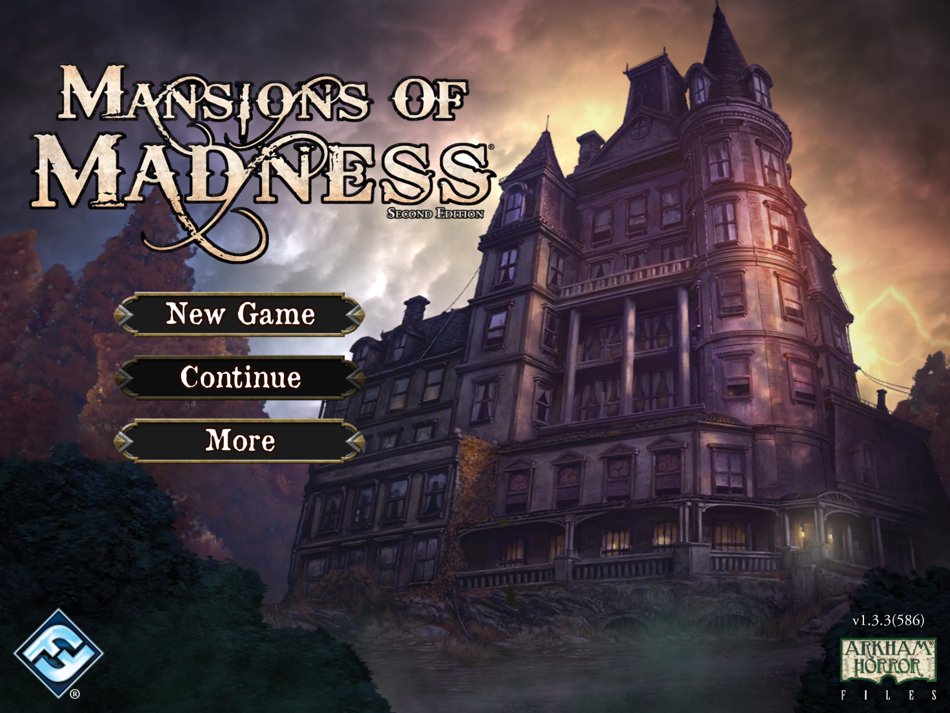Stuffed Fables – Bedtime stories as a cooperative game

Toy Story movies are still some of my favorite movies.
I love the idea of our toys having a purpose. And Pixar knows how to breath depth of character into them throughout their adventures.
Well, a few years ago, Plaid Hat Games brought that concept to life in a cooperative board game that’s fantastic for families called Stuffed Fables.
The game is a cooperative adventure game where the main characters are “stuffies” (stuffed animals) working together to save the child they love from a scheming, evil mastermind.
It’s also an “Adventure Book” game where the game board is actually a physical book teaming with adventures on every page.
And it works wonderfully!
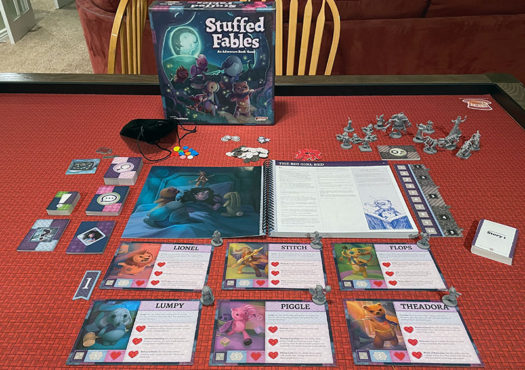
How to play Stuffed Fables
Stuffed Fables is a cooperative board game where each player takes on the role of one of the stuffed animals working to help their child. It’s played over a series of 7 stories that are each comprised of various adventures.
To begin, players pick their stuffy and get the associated character card and miniature. When players are ready to dive into a new story, they take the cards from the Discovery Deck related to that story and set them aside. As the players progress, the adventure book tells them when they encounter those items and players will then bring those cards (items, minions, etc.) into play.
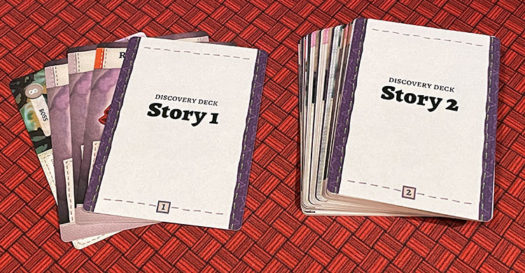
Then one player starts reading the story and you’re off.
The story tells the players what’s happening and where to place their miniatures on the first page to begin exploring. Then players take turns trying to achieve the main goal. As they hit certain points, they’ll have choices in how to proceed with the story and will be directed to different pages of the adventure book.
The book is spiral bound and lays flat on the table with one side being the “board” and the other side having the story, goals, and special rules for that scenario.
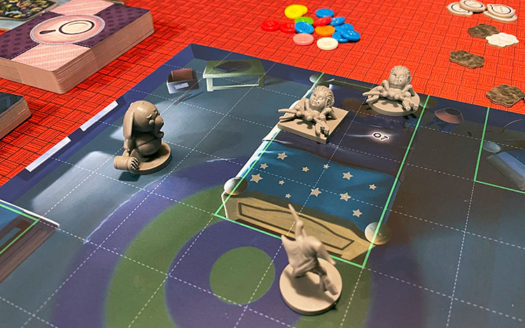
On a player’s turn, they’ll draw 5 colored dice from the bag and use those dice for different actions.
White dice can grant the stuffies extra stuffing that they may have lost in battle. Red dice are used in melee attacks and green dice are used in ranged attacks. Yellow dice are used for searching while blue dice are used for special actions. Purple dice are “wilds” and can be used as any color. And the black dice are placed on the minion track. When enough of the black dice are out, the minions will take a turn and attack the stuffies.
All the dice (except the white and black) may also be used for moving, using items, or contributing to group tasks.

When a player chooses to use a die, they roll it and use the resulting number. For example, if they want to use a blue die they drew from the bag to move, they’ll roll it and then can move up to that number of spaces. Once used, the die is discarded.
Players can also store one die on their stuffy card to use in a future turn or for defensive rolls when minions attack. They can also give one of their dice to another player to help them out or share some of their stuffing.

Players can also use the yellow dice to Search and draw cool things from the Item deck to use in their adventure. There are also special spaces on the boards where players can encounter lost toys and make a choice in how to help them that may also garner rewards.

When players defeat a minion, they earn a button. Buttons can be used in some scenarios to purchase other cards/items to equip. And players can earn hearts along the way as well that can be spent to use their stuffy’s special abilities.
When the minion track has an equal or greater number of black dice on it than there are minions, the minions take a turn. Starting at the top minion on the track, a player rolls the black die next to the minion card. The result indicates what actions that minion will take. Once that minion has acted, the next black die is rolled and that minion activates and so on.
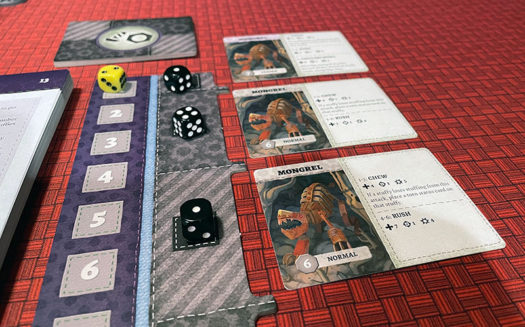
Once all minions have activated, all the black dice and those in the discarded dice pool are placed back in the bag and stuffies continue taking their turns.
The Adventure Book tells players when to move ahead to different sections of the story and turn pages. When a page is turned, all the pieces are removed from the board and the next page will instruct on how to set up the next part of the adventure.

If it’s the end of a story, one player will read the finishing storyline. The end will differ slightly depending on if the child was sleeping, restless, or waking when the players completed their goal.
The ending of each story also includes a “Talking Points” section with topics to discuss with the players.

Can the whole family enjoy Stuffed Fables?
Stuffed Fables is a family game through and through.
The theme is fantastic for families with young kids to play together. The storylines in each story, adventure, and scenario are fun and engaging and the challenges are straight forward.
The artwork on every “board” is colorful and the layout of each map so unique that they’re all fun to play.
The Adventure Book itself is over 100 pages long. Most of those have an adventure map on the left page with the story and special rules on the right. But the last 10 pages or so are all text since that’s where you turn at the end of a story to read how it concludes.

While we don’t have young kids in our household currently, I can’t wait to play Stuffed Fables with future grandkids. I can picture this being a perfect game to play before bedtime. Even though each story may run about an hour and a half, the game can easily be set aside at any of the page breaks.
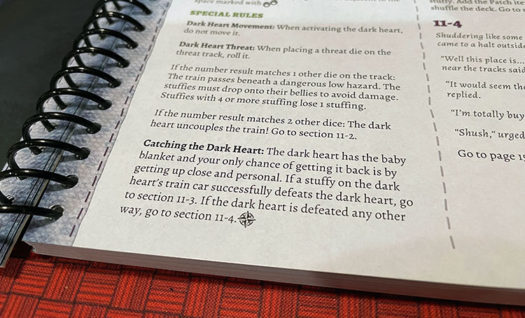
For example, the first story takes place over 5 different page spreads. So depending on how much time you have, you can stop at different points along the way.
Or, if your kids are clamoring for more and don’t want to stop in the middle of a story, you can just keep on going.
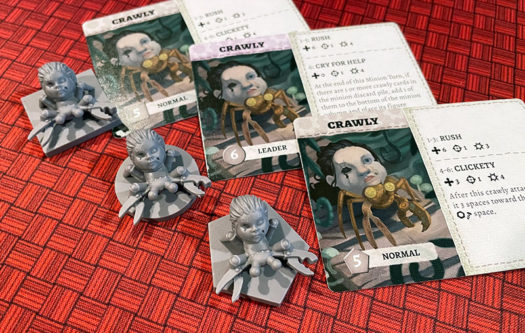
The game play is also very straightforward to all players to grasp. Pull out some dice, choose which ones to use based on what you want to do, and then roll them to use the results.
There’s definitely an element of luck in both the dice draw and rolls, but that’s what keeps players on their toes for the unexpected.
For example, you may have a ranged weapon, like Rubber Bands, but not draw a green die on your turn to let you use it. However, that is mitigated somewhat by the purple dice being “wilds” and the chance other players have to give you a die on their turns. So when they draw a green die, they could give it to you to use on your next turn.

Dice can also be combined for larger results. For example, when going up against a minion with a health of 8, you’ll need to roll at least 2 dice to be successful against it.
We also think it’s great that instead of “health” points, the stuffies have “stuffing” that they lose in minion attacks. And if they run out of stuffing, they collapse. On future turns, if they draw white dice, they will roll them to gain more stuffing and get back up. Plus players can spend a die to give another player one of their stuffing, so players aren’t really going to be knocked out of the game.
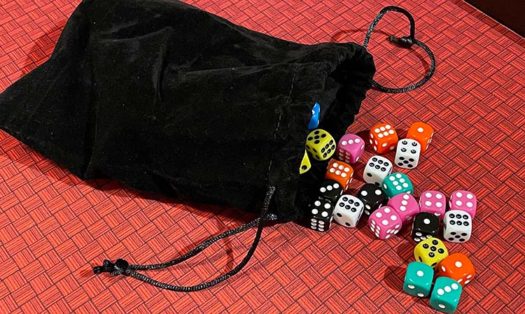
As a parent (and future grandparent), I also love that Plaid Hat Games includes a Talking Points section at the end of each story. They each present topics to discuss with your children that are relevant from the just-completed story.

How does Stuffed Fables score on our “Let’s Play Again” game meter?
 Since we don’t have young kids in our home currently, it’s a bit hard to set a score on our “let’s play again” game meter.
Since we don’t have young kids in our home currently, it’s a bit hard to set a score on our “let’s play again” game meter.
That being said, Stuffed Fables is definitely going to be ready when future grandkids are having sleepovers at grandma and grandpa’s house!
With fun storylines, choices to advance the stories, cooperative game play, great artwork and miniatures, items to collect, and distinct objectives to achieve, Stuffed Fables is a great game to have on our family board game shelves.



